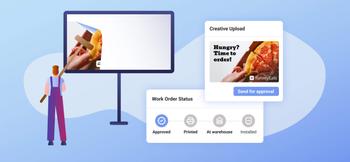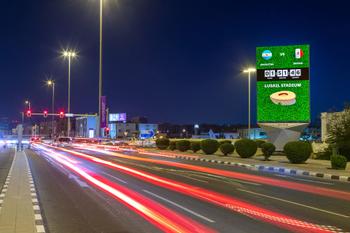Managing a static out-of-home (OOH) network shouldn’t be complicated, but it unfortunately often is. Many static media owners still rely on a manual campaign management solution, like a lengthy and complex spreadsheet, to run their entire static OOH business. While this may still be feasible for smaller companies with only a couple of boards to manage, it can become difficult to manage if you have a hybrid network or plan to scale your business.
The bigger your business, the more complex it becomes to manage manually, increasing the chances of mistakes and lost revenue. Why opt for a manual process when dedicated platforms exist to assist you in the management of your static OOH business, streamlining nearly all aspects of running your network?
There are many software solutions out there, and deciding which is the best fit for your business can be overwhelming. What features are needed to run my network efficiently? Will the software grow with my business? Whether you’ve been on the market for a new solution for a while or just started looking, these are probably familiar questions.
We enlisted the help of our in-house static OOH expert and senior product manager, Myriam Bordeleau, to put together the top features to look for in a static OOH management solution.
Automated workflows for increased operational efficiency
“Any and all processes should be automated,” says Myriam. “Being able to easily and quickly build a proposal, send it to the client for approval, and manage the campaign should be key considerations for media owners when choosing a solution.” By automating manual processes, such as booking confirmations, generating invoices and communications with stakeholders, you eliminate the risk of mistakes and enable your teams to concentrate on the end result, delivering the campaign.
Scalability and flexibility is key to a good static OOH management solution
Another important feature of a good static OOH management solution is scalability and flexibility. Here’s Myriam to explain why:
Robust asset management capabilities are non-negotiable
The software you choose needs to have robust asset management capabilities, allowing you to centralize and easily keep track of all the data you need on your ad spaces, from specs to localization to operational information. “In addition to keeping track of active spaces,” adds Myriam, “you should also be able to set inactivity periods for assets under maintenance, or retire those that no longer exist.”
Depending on how you sell your inventory, the solution you choose should have the capability to build packs, which are assets that are sold together for more efficient booking and selling. For example, if you have faces in a shopping mall, you might want to sell these together so that advertisers can display their ads across that location.
Key features to help your static sales team close deals more quickly
Without realizing it, your sales team might be losing deals due to slow turnaround times. Here’s Myriam to explain to why real-time availability is a key feature for sales:
Another useful feature to consider for your sales team is rate cards, which are used to determine the value of the faces for the time sold, helping you keep your selling margins where they need to be. More specifically, the solution you choose should include media and additional revenue cards to help you define the rates for content creation, production, installation, fines and fees. This allows your sales team to compile a proposal more quickly, as they can easily compile and calculate the total cost with rate cards.
An end-to-end solution cuts down the time it takes to go from booking to posting
“Chartists are the core of any media owner business,” says Myriam. “For that reason, they should be able to access any and all relevant features that will make their work more efficient through one fully-loaded easy to navigate UI.” By allowing chartists to plan and schedule campaigns in one place, including defining campaign objectives, selecting locations, setting start and end dates, and allocating budgets, they can quickly assess what a client needs to successfully execute their advertising campaign, and cut down the time it takes to go from booking to posting.
Centralize your creative asset management for full visibility into the production and delivery process
Unlike DOOH, static OOH ads need to be printed and posted onto a billboard which makes the production and delivery process a bit more complex. For this reason, having a centralized tool to manage all your creative assets, allow users to upload, organize and associate them with specific campaigns can ensure that nothing falls through the cracks. Here’s Myriam to tell you more on creative asset management:
Collaboration and communication features to keep internal and external stakeholders posted
To get static OOH out the door is a team effort. You are often required to work with different departments, teams and external vendors. “Being able to have real-time information readily available is critical in making sure that campaigns are posted on time,” says Myriam. “The software you choose should include collaboration and communication features so that both internal and external stakeholders, including bill posters, can provide their updates.”
Your solution should have proof of performance reports that include pictures and posting completion dates
Unlike DOOH, proof of performance (PoP) reports in static require photographic proof. Here’s Myriam on what your solution should include for proof of performance to advertisers and agencies:
You need comprehensive reporting capabilities to make data-driven decisions
Managing a static network requires a lot of reporting capabilities to maintain a healthy and profitable business. These insights help you assess the effectiveness and return on investment of your advertiser’s campaign and monitor production and operation statuses. “Being able to analyze and compare trends in the advertising space with your own metrics is where reporting capabilities are very important for growth,” says Myriam. “Sales reports are a must, and not just for the media, but for other campaign-related costs”, she adds. “Your reports should be able to tell you the state of your network and its occupancy percentage, so that you may adjust your sales accordingly.”
Now that you have a better understanding of what to look for when searching for a static campaign management tool, you can make an informed decision on which solution best fits your needs. And in case you didn’t know, we recently integrated robust static OOH management tools into the Broadsign Platform. This addition allows you to effortlessly execute static campaigns from start to finish.






